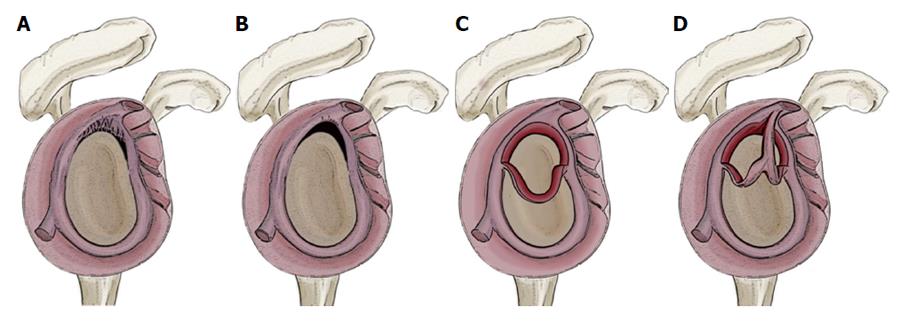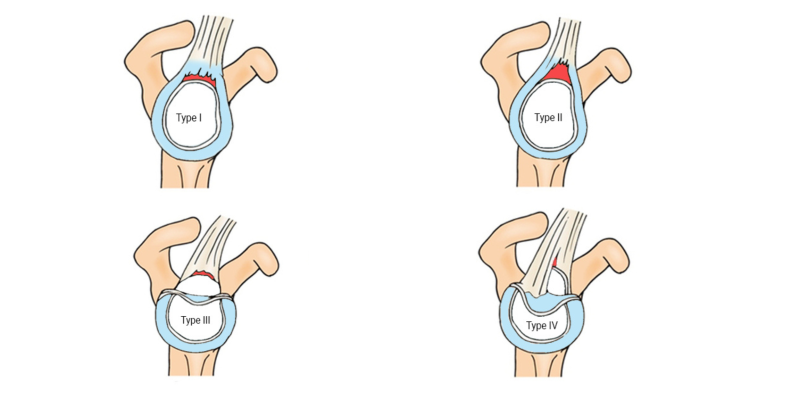Superior labral lesions (SLAP Tear) are a common occurrence in the athletic population, especially overhead athletes. The first description of labral tears involving the superior aspect of the glenoid was described by Andrews et al,(Read more).
A total of four types of superior labral lesions involving the biceps anchor have been identified. Type A concerns degenerative fraying with no detachment of the biceps insertion. Type B is the most common type and represents a detachment of the superior labrum and biceps from the glenoid rim. Type C represents a bucket-handle tear of the labrum with an intact biceps tendon insertion to the bone. Finally, type D lesions, the least common type represents an intra-substance tear of the biceps tendon with a bucket-handle tear of the superior aspect of the labrum.

What is the cause of a SLAP tear:
There are a lot of different mechanisms of injury that can result in a SLAP lesion. A subsequent study found that the most common mechanism of injury was a fall or direct blow to the shoulder, occurring in 31% of patients. A significant number of patients with superior glenoid lesions and concomitant impingement or rotator cuff disease in the absence of trauma has also been identified. In addition, the following clauses have been found in patients who diagnosed with a SLAP tear.
- Repetitive throwing,
- Hyperextension,
- A fall on an outstretched arm,
- Heavy lifting,
- Direct trauma.
However, the two most common mechanisms are falling on an outstretched arm in which there are a superior compression and a traction injury in the inferior direction. Falling on an outstretched arm is an acute traumatic superior compression force to the shoulder. In this situation, the shoulder is abducted and slightly forward-flexed at the time of the impact.
Throwers can have repetitive microtrauma. At the moment of the impact, the glenohumeral contact point is shifted posterosuperior and increased shear forces are placed on the posterior-superior labrum, which results in a peel-back effect and eventually in a SLAP lesion.
What are the symptoms:
The most common complaint in patients that present with SLAP lesions is a pain. Pain is typically complained of vague shoulder pain, often with clicking, popping, or snapping that is usually exacerbated with overhead activity. They may also complain of instability if the lesion extends to the anterior labrum/ capsule. We have listed some of the common symptoms as follow.
- – Deep, aching pain.
- – Popping, clicking, catching, locking or grinding in the shoulder.
- – Decreased range of motion.
- – Shoulder instability.
- – Pain when lifting or carrying objects.
- – Decreased shoulder strength.
Physical Examination and Patient History
Your physical therapist will take you through an objective and subjective assessment. The physical examination will be carried on and The Passive-compression test which has been shown to be helpful in diagnosing SLAP lesions.
Do you need an MRI or MRA?
MRI is the gold standard imaging modality for diagnosing SLAP lesions. However, the reliability of MRI to diagnose SLAP lesions has been disputed. Several studies have found difficulty diagnosing labral lesions with standard MR techniques (Read more). Studies comparing conventional MRI to magnetic resonance arthrography (MRA) with significant improvement in sensitivity and accuracy with little or no reduction in specificity in favor of MRA (Read More).
Conservative Treatment
Your physical therapist will be customized your treatment and rehabilitation program which will be individualized. Treatment recommendations usually include POLICE protocol in the acute phase and active rest from painful activities, nonsteroidal anti-inflammatory drugs, and rehabilitation. The rehabilitation program is oriented towards stabilizing muscles of the shoulder “rotator cuffs” and shoulder girdle in order to regain normal muscle strength, neuromuscular activation, and adequate proprioception exercises.
Exercise rehabilitation for a SLAP tear
As we highlight, the exercise rehabilitation program is oriented towards strengthening the dynamic stabilizer of the shoulder “rotator cuffs” and shoulder girdle in order to regain normal muscle strength, neuromuscular activation, and adequate proprioception exercises.
Phase 1 (Isometric Exercises)
After POLICE protocol in the acute phase and active rest from painful activities, the Isometric exercises that work on the internal, external rotators, abduction, and adduction of your shoulder will be prescribed and demonstrated by your physical therapist. Isometric exercises should be completed without pain and they are a great start since they will help you to activate those muscle and also reduced your pain specifically if you are experiencing rotator cuff tendinopathy. Research supported a single resistance training bout of isometric contractions reduced tendon pain immediately for at least 45min (Read more).
Phase 2 (Resistant Band)
The second phase of your rehabilitation will be utilizing a resistance band on a daily bases. External and internal rotation of shoulder will be the 1st exercises to start with and you will progress with abduction, adduction, and pullbacks. The sets and repetitions will be prescribed with your physical therapist depending on the needs of the individual.
Phase 3 (Active ROM & Scapular Activation)
In this phase of rehabilitation, we are looking to improve the active pain-free (ROM) range of movement. We also show you how to engage in scapular exercises daily.
Before trying these exercises make sure to consult your physical therapist. If you have any question feel free to contact us through [email protected]
Our Approach
Dublin Sports Injury Clinic is a physical therapy clinic based in Fitzwilliam Square, Dublin2. we have a holistic approach to our assessment and treatment. The initial assessment helps us to explore the cause of your injury and help you to get pain free shortly and stop any further injuries. We will design a customized training program for you to start with, and we coach you and monitor your progress closely. We will prescribe relative rest or modified activities as required. In addition, the patient’s education helps to reduce frustration and encourages compliance. In our clinic, the treatment of SLAP tear will be tailored to every individual.
Next step
Want to get in touch with our team of our therapist or you are looking for some advice? Simply fill in your details below & we get in touch with you shortly.
Disclaimer: This article is for information only and should not be used for the diagnosis or treatment of medical conditions. You can contact us if you would like to book an appointment or get some advice from our therapist.
